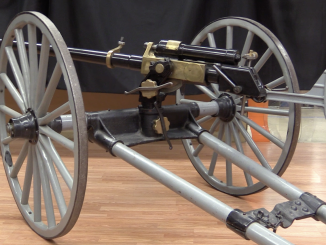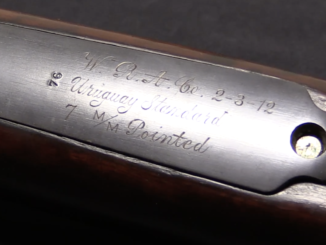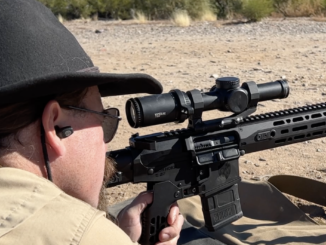When someone says “Old West Colt”, the first thought is usually not double barreled shotguns. However, Colt made two quite high-end side-by-side shotguns during this period, and they played a role in the remarkable Colt/Winchester market-fixing agreement.
Colt’s Model 1878 was an exposed hammer double gun that competed closely with high-end Parkers, and sold a total of about 23,000 guns. This was followed by the Model 1883, a hammerless design in line with the cutting edge technology.




Video is for a previous one for a copy of Savage pistol.
For when that happens, the Full30 page is often a few days ahead.
Me too. Please re-send the video on the Colt shotgun.
Some people likely had issues with hammerless double-barrel shotguns primarily due to the hammers of older shotguns serving to tell that the barrels were loaded and that a trigger pull would indeed result in something (or someone) getting sprayed with lead pellets from one barrel or the other. This is the same reason why the US Army was reluctant to adopt bolt-action rifles early on-no way to tell if the chamber had a live round in it (Ward-Burton rifle did not have striker indicator, so of course the accidents involving soldiers’ knees getting shot with unknowingly loaded rifles were bound to follow). With hammerless shotguns, the only way to tell if the chambers are loaded is to open the action slightly and peek. The disadvantage to shotguns with external hammers is that there’s a longer firing time (from the instance one pulls the trigger to the shell firing) because the external hammer has more inertia to overcome as spring tension swings it towards the firing pin.
Did I mess up anything?
Can’t be shotgun equipped with empty/full chamber indicator?
So far I know it was used on some automatic pistol (for example Lahti L-35), if I am not mistaken it is actuated by extractor claw.
Does anyone try to use indicator on shotgun?
Which is first automatic pistol to have this feature?
There are some modern high grade doubles
That are made with cocking indicators.
I ask about chamber full/empty indicator, not cocked/uncocked indicator
You have to understand how double shotguns were used back then.
First of all, a high-end (mucho $$$$) double like the Colt would be a “carriage trade” item. It would mainly be used for shooting upland game over dogs (grouse, etc.).
As such, it would be used like a high-quality English double (which was what Colt wanted to compete with in the American market), and the customer would be interested in the most modern gun that swung the best, had the fastest lock time, etc.
It wouldn’t be left loaded at home (a loaded gun in the case? Quelle horreur’!), so spring tension would be irrelevant.
Most such guns would be full choke or at the very least modified choke, for maximum shot pattern density out to maximum effective range. (About 50-60 yards; note that no. 3 shot was the most common size used back then, precisely because it was considered better for hitting high flyers with.)
A “house gun” or “coach gun”, by comparison, was at the low end of the economic/class spectrum, and had very different characteristics. Most had barrels of between 20″ and 26″ length, with 24″ being about average. Most were either cylinder bore or at most Improved Cylinder, and typical shot loads were No. 5 or 6, if being used for birds. The difference being that farmers using the shotgun to forage shot the birds on the ground, not in the air, at ranges under 30 yards.
As a side note, that was exactly the way the aristocracy hunted birds in medieval and Renaissance times, with crossbows (called “prodds”, that fired a stone or clay pellet rather than a bolt), or with firearms.
When Leonardo da Vinci referred to shooting birds with a “muskete” in his Codex Atlanticus, people today marvel at his eyesight and reflexes. They don’t understand that what he was doing was the equivalent of shooting a rabbit that was sitting still, on the ground.
As a coach or house gun, such a shotgun would have been loaded with either buckshot (generally size 0 back then, not “double-ought”), or a “punkin ball”, a round ball like a musket ball of bore size, in at least one barrel. (The modern-day “rifled slug” wasn’t around back then; Wilhelm Brenneke first developed it in Germany in 1898. The American Foster version was only patented in 1931.)
The house gun would have to be ready to go at any time, no matter what. So it would be stored loaded. The traditional “hung on two pegs over the kitchen door or fireplace” thing was how it really was generally done.
For this reason, outside hammers were preferred on the “low-end” guns. Not only was that system easier and cheaper to machine than a pair of hammerless sidelocks or a hammerless double boxlock, it could be stored loaded, with the hammers down, all springs relaxed, until needed. Then, grab it, haul both hammers back, and you’re in business.
If you’re interested, here’s a book on the subject written at the time. It covers rifles, revolvers, and shotguns, but puts a great deal of emphasis on the latter, because that was the author’s own main line of business;
Modern Breechloaders- William Greener
https://books.google.com/books?id=PXkZAAAAYAAJ
What he has to say about converting double percussion muzzle-loading shotguns to metallic-cartridge breechloading is interesting, to say the least. No, he didn’t think much of the idea.
cheers
eon
In Sweden (as in the Kingdom of Sweden) the crossbow was the most common hunting weapon from the late Middle Ages (ca. 1300) all the way to early 18th century. Crossbows were used for all kinds of hunting, including birds on the ground, by everybody who had sufficient means to own such a weapon. Once the wheellock was invented, firearms slowly replaced crossbows starting from the nobility (which in Sweden was numerically a very small group of people), but peasants continued to use them at least into the early 1700s, and possibly even later.
My Great-Great-Grandfather (a farmer) was given an 1873 Colt Shotgun by a friend of his in the 1880s because his friend knew that he needed a shotgun. He used it for hunting deer and such.
Not sure where you got the idea that hammer shotguns tell you when they’re loaded. They don’t. A hammer shotgun can be loaded with the hammer down, or at half-cock, or at full-cock, and they don’t look any different from the outside than an empty gun. The hammer does not move when you open the gun, it stays right where you put it. Over the years hammer guns have been involved in accidental shootings just like any kind of gun. I’d say that soldiers have shot themselves accidentally with every firearm ever put in their hands. There is no such thing as a fool-proof gun.
Hammerless shotguns are considered safer than hammer shotguns for many reasons. Most hammerless shotguns have much better drop-safety than hammer guns, since the only real drop-safety on a hammer gun is the half-cock notch, and even then the firing pins are exposed on the outside of the gun. You will notice that must hammerless shotguns actually have a safety, it’s usually on the tang, and it often goes on-safe every time you open the gun. This is why hammerless shotguns were often sold as so called “safety shotguns.”
The main reason why hammer shotguns continued to be popular after the introduction of the hammerless is because of price. I’ve got a copy of the Spring 1896 Sears, Roebuck catalog in front of me. The cheapest Parker hammer gun went for $35.38, and the cheapest Parker hammerless for $41.70. (BTW, the Colt hammerless is also in this catalog priced at $51.30.) The high-end of the offerings in this catalog are in the $200.00 range, and they are imported shotguns from Birmingham, England. No Purdey guns were sold at Sears. ^__^
Generally you only see the hammer up when someone is about to shoot something. It’s a coconut effect from stuffy moss-backs. Hammer-less shotguns may be safer but still, if the gun is off the rack and clearly held with one’s finger on the trigger, I’m going to assume it’s probably loaded to kill something. And when that’s the case with external hammer shotguns, I don’t want to see any pointed in my general direction with the hammers ready to strike, loaded or not. Otherwise it’s likely to be a hospital bill and a lawyer’s fee afterwards should the worst happen.
Regarding “fool proof” – we used to say in submarines “If it is solid enough to be sailor proof it is too damn heavy to float.” If you can’t break it, some E3 will “float test” it – i.e., drop it overboard.
And on “carriage trade” versus mass market – that is a line that Colt danced around for a century. You paid about 30 cents on the dollar for the Colt name. I remember looking at Pythons and (drool, slobber) .22 6″ Diamondbacks and there was always something else in the same caliber for about two-thirds the price that worked just as well, if not better.
Hopefully, you don’t have seen price in Western Europe : from 300€ for a 2nd-hand double barrel shotgun and around 450€ for a cheap brand new one.
Just always assume it’s loaded? That usually keeps things safe. = 0
Pretty wood. Nice looking gun. I’d guess it has Damascus steel barrels.
The British shot gun market was broadly broken up into to segments. “Birmingham” guns (as mentioned in the video) were the cheaper end of the market. They were considered to be good quality but low cost mass market guns. As the name suggests, those gun manufacturers tended to be located in and around Birmingham.
“London” guns were (and still are) the top end of the market. I don’t think that $20,000 would even get you a second hand shotgun from a top London gun maker today. I just had a look at the Holland and Holland web site, and they were listing new guns (sold only in matched pairs) at £80,000 to £100,000 and up. And that’s for the guns that they give a price for.
Given the above, I suspect that a good quality Birmingham gun would have been more in line with what Colt was producing. You might call it the top end of the mass market guns, but it’s not even the bottom end of the “real” top end gun market.
The 1883 gun looks to have a “Damascus” barrel. That type of barrel was perceived to be of higher quality. I’m not sure if by that date they really would have been better than barrels made using more modern materials and technologies, but it does suggest that Colt was trying to present it as being a cut above the run of the mill guns.
By the way, I found the history of these guns to be quite fascinating. This was an excellent video. And I didn’t find these guns to be “boring” at all, and wouldn’t have minded a closer look at them.
From early 20th century about hunting weapons (from Europe perspective):
Without doubt English weapons are the best, especially: Purdey, Greener, Holland and Holland, Scott, Westley Richards. Other good makers are: Belgium: A.Lebeau, Francotte, Pieper; France: Pirlet, St. Etienne; Germany: Sauer, Heym; Austria: Springer; Sweden: Husqvarna Wapenfabrik, America: Remington, Winchester
I remember reading documents about Belgian manufacturers in struggle between traditional Damascus barrel versus modern bored one. It appears this technological shift was perceived as a threat by a part of gunmakers.
If I am right, their union tried to defend the advantages of Damascus barrel (during accident, the barrel changed shape instead of exploding, know-how of Belgian makers, employment issues…) but we know the rest of the story : bored barrel were faster to make an can resist higher pressures.
Are the pattern welded barrels made in US? I never heard of barrel forges in the US.
http://www.rockislandauction.com/viewitem/aid/60/lid/1052